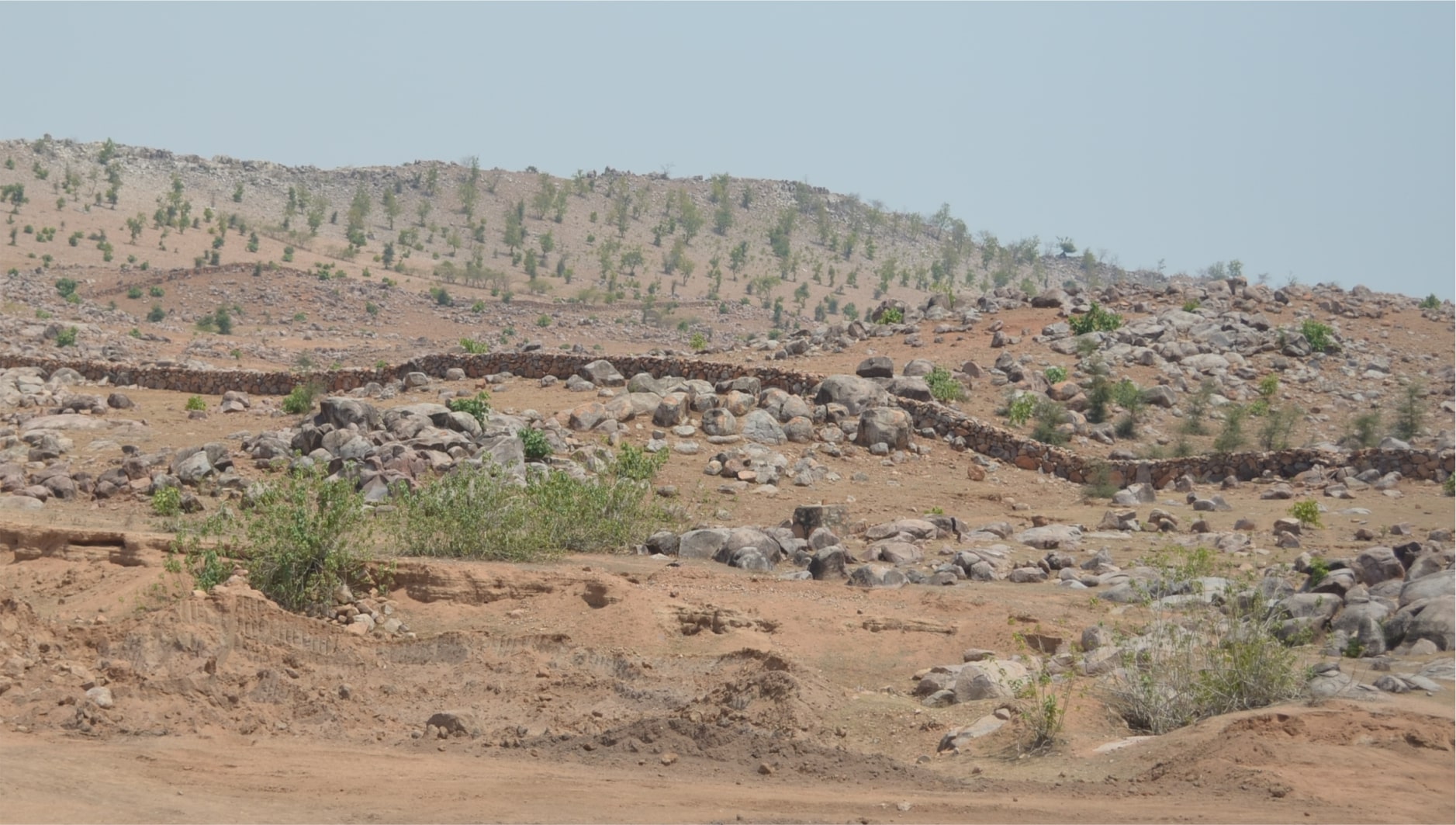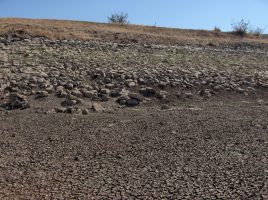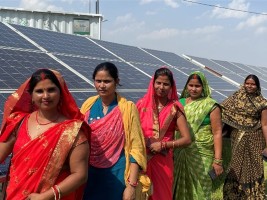Addressing Land Degradation, Desertification and Drought to Tackle Climate Change

Land degradation in Bundelkhand
Desertification, land degradation and drought (DLDD) gained attention at the Rio conference in 1992 along with climate change and biodiversity loss. Emerging from the concern that ecosystems were becoming degraded, affecting livelihoods, reducing resilience to climate shifts, actions for sustainable land management gained momentum. It is well understood that poly-crisis has a significant implication on food security and can often be exacerbated due to social conflict, limited infrastructure and financial stability.
Land degradation data for India reveals a complex pattern of degradation driven by a combination of natural factors and human activities. The Government of India has been addressing these challenges through targeted interventions, especially in arid and semi-arid areas, by focussing on afforestation, sustainable land and ecosystem management and improving agriculture and water conservation practices.
Management of land degradation has co-benefits for climate change mitigation, adaptation and biodiversity conservation, in addition to enhancing food security and sustainable livelihoods. Moreover, achieving land degradation neutrality (LDN) requires three concurrent actions:
- Avoiding new land degradation through maintaining existing healthy land.
- Reducing existing land degradation by adopting sustainable land management practices.
- Making efforts to restore and return degraded lands to a natural or more productive state.
Land Degradation Neutrality Pathways for India
Land degradation data for India reveals a complex pattern of degradation driven by a combination of natural factors and human activities. According to the Space Application Center (SAC) under the Indian Space Research Organization (ISRO), revealed that as of 2011–13, 29.32% (96.4 million hectares, Mha) of India is experiencing LDD*, growing from 28.76% (94.53 Mha) in 2003–05 [1]. Erosion is the prime driver of LDD in India, accounting for over 16% of the total LDD national area (water erosion accounts for about 11%, while wind accounts for about 5.55%). It negatively affects land productivity, crop yield, farm income and livelihood. Other major reasons for LDD in India include vegetative degradation, salinity, water logging, human dynamics (including settlement and man-made) and frost shattering. The Government of India has been addressing these challenges through targeted interventions, especially in arid and semi-arid areas, by focusing on afforestation, sustainable land and ecosystem management, and improving agriculture and water conservation practices.
India’s approach to tackling land degradation and drought has involved a combination of national policies, state-level initiatives and international cooperation. At COP 2015 in Paris, India joined the voluntary Bonn Challenge pledge to bring into restoration 13 Mha of degraded and deforested land by 2020 and an additional 8 Mha by 2030. This pledge to restore 21 Mha by 2030 has been increased to 26 Mha during the COP14 in 2019 [2]. India has committed under the Paris Agreement to increase carbon sequestration through forests by 2.5-3 billion tonnes of carbon dioxide equivalent by 2030. India’s national targets on restoration support the implementation of national priorities on sustainable development goals while contributing to the achievement of international commitments on climate change, biodiversity and land degradation [3].
On the national front, India has launched several schemes/programmes. These initiatives include the National Afforestation Program, the Green India Mission, and the Watershed Development Component of Pradhan Mantri Krishi Sinchayee Yojana (PMKSY). These programs aim to restore degraded land and achieve land degradation neutrality by focusing on the sustainable and optimal utilisation of land resources. They target restoration of 26 Mha of degraded land and achievement of land degradation neutrality with a focus on sustainable and optimum utilisation of land resources. The Watershed Development Component (WDC) of Pradhan Mantri Krishi Sinchayee Yojana, launched in 2015, plays a significant role in land restoration through various interventions such as building water harvesting structures, expanding protected irrigation areas, and increasing plantation areas through afforestation and horticulture [4]. Based on ecological and geographical conditions and extent of degradation, 15 states of India including Andhra Pradesh, Chhattisgarh, Gujarat, Jharkhand, Karnataka, Madhya Pradesh, Odisha, Rajasthan, Telangana, Uttar Pradesh, Uttarakhand, Tamil Nadu, Himachal Pradesh, West Bengal and Maharashtra, have been identified for interventions to achieve the LDN targets. These states account for more than 25% of the country’s geographical area, with a total area of 83.78 Mha under desertification. In the Open Forest Area, only 30% of open forest areas are suitable for afforestation and can be treated to achieve LDN [3]. In addition to national programmes, various Indian states have implemented their own policies and initiatives to combat land degradation and drought. For example, Gujarat has the Sujalam Sufalam Jal Sanchay Abhiyan, a water conservation campaign focused on increasing water storage and groundwater recharge through community-based projects. Bihar has the Jal Jeevan Hariyali Abhiyan, which promotes water conservation, reforestation and sustainable land use practices. Telangana’s Haritha Haram is a large-scale afforestation programme targeting degraded lands and promoting green cover.
On the occasion of International Day of Forests 2023, the Ministry of Environment, Forest and Climate Change, Government of India announced plans to revive the Aravalli region. The initiatives include implementing a single-use plastic ban, launching water conservation efforts and protecting natural resources. These efforts aim to green the 5 km buffer area around the Aravalli Hill Range in Haryana, Gujarat, Rajasthan and parts of Delhi NCR [5].
The UN Decade on Ecosystem Restoration 2021-30 provides an opportunity to jointly address ecosystem degradation and take measures for restoration, and the Aravalli Green Wall Project [6] can be one of the initiatives in this context.
Conclusion
India aims to mitigate the effects of land degradation and drought and promote sustainable development through sustainable land and water management, reforestation and climate resilience. Through this edition of the newsletter, Development Alternatives aims to raise awareness and urge action to protect the country’s biodiversity.
References
[1] SAC. 2016. Desertification and Land Degradation Atlas of India (Based on AWiFS Data of 2011–2013 and 2003–2005). Ahmedabad: Space Application Center. Details available at https://www.sac.gov.in/SACSITE/Desertification_Atlas_2016_SAC_ISRO.pdf
[2] Ministry of Environment, Forest and Climate. 2023. Land degradation and desertification. Details available at https://pib.gov.in/PressReleaseIframePage.aspx?PRID=1946401
[3] Singh, S., Giri, K., Mishra, G., Kumar, M., Singh, R.K., Pandey, S., Mullick, M., and Sharma, R. 2023. Pathways to Achieve Land Degradation Neutrality in India. Dehradun: Indian Council of Forestry Research and Education. Details available at https://icfre.gov.in/publication/publication51.pdf
[4] Ministry of Agriculture & Farmers Welfare. 2023. Loss of soil fertility. Details available at https://pib.gov.in/PressReleasePage.aspx?PRID=1897010
[5] Ministry of Environment, Forest and Climate. Annual Report 2023-24. New Delhi: Ministry of Environment, Forest and Climate. Details available at https://moef.gov.in/wp-content/uploads/2024/03/Annual-Report-English-2023-24.pdf
[6] Ministry of Environment, Forest and Climate. 2023. Shri Yadav unveils National Action Plan to Combat Desertification and Land Degradation through Forestry Interventions, Details available at https://pib.gov.in/PressReleaseIframePage.aspx?PRID=1910745
* Land Degradation and Desertification
The views expressed in the article are those of the authors and not necessarily those of Development Alternatives.
This blog first appeared as an editorial in Development Alternatives Newsletter May, 2024 https://devalt.org/newsletter/44






Leave a Reply